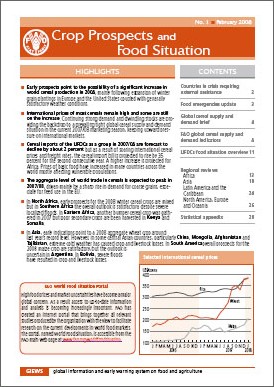Rome, Italy
February 13, 2008
Early prospects point to the
possibility of a significant increase in world cereal production
in 2008, but international prices of most cereals remain at
record high levels and some are still on the increase, FAO said
today.
 The
forecast increase in production follows expansion of winter
grain plantings and good weather among major producers in Europe
and in the United States, coupled with a generally satisfactory
outlook elsewhere, according to FAO’s latest
Crop
Prospects and Food Situation report. The
forecast increase in production follows expansion of winter
grain plantings and good weather among major producers in Europe
and in the United States, coupled with a generally satisfactory
outlook elsewhere, according to FAO’s latest
Crop
Prospects and Food Situation report.
With dwindling stocks, continuing strong demand for cereals is
keeping upward pressure on international prices, despite a
record world harvest last season, the report said. International
wheat prices in January 2008 were 83 percent up from a year
earlier.
Although prices are high, total world trade in cereals is
expected to peak in 2007/08, driven in great part by a sharp
rise in demand for coarse grains, especially for feed use in the
European Union, according the report.
Imports down, food bill up for poorest countries
Cereal imports for all Low-Income Food-Deficit countries in
2007/08 are forecast to decline by about 2 percent in volume,
but as a result of soaring international cereal prices and
freight rates, their cereal import bill is projected to rise by
35 percent for the second consecutive year. An even higher
increase is anticipated for Africa. Prices of basic foods have
also increased in many countries worldwide, affecting the
vulnerable populations most, the report said.
In order to limit the impact of rising cereal prices on domestic
food consumption, governments from both cereal importing and
exporting countries have taken a range of policy measures,
including lowering import tariffs, raising food subsidies, and
banning or imposing duties on basic food exports.
New portal
“High food prices and market uncertainties have become major
global concerns, and wide access to up-to-date information and
analysis is becoming critical,” said Henri Josserand of FAO’s
Global Information and Early Warning system. To address this
need for information and facilitate analysis on current
developments in world food markets, FAO today announced the
launch of a new web portal bringing together relevant FAO
studies and data on the world food situation.
2008 cereal prospects
In North Africa, early prospects for the 2008 winter cereal
crops are mixed, but in Southern Africa the overall outlook is
satisfactory, despite severe localized floods. In several
countries of Eastern Africa, another bumper cereal crop was
gathered in 2007, but poor secondary crops are expected in Kenya
and Somalia, according to the report.
In Asia, early indications point to a 2008 aggregate wheat crop
around last year’s record level.
Overall prospects for the 2008 maize crop are satisfactory in
South America, although the outlook remains uncertain in
Argentina.
Flooding in southern Africa and South America
Heavy rains have caused severe flooding in Mozambique, Zimbabwe,
Zambia and Malawi. Farmers in affected areas are in urgent need
of seeds and other inputs for replanting during what is left of
the main cropping season, which runs from October to April, and
to prepare for the next planting season.
FAO and its humanitarian partners yesterday launched an appeal
for $87 million for emergency assistance to flood-affected
populations in the four countries. Of this, over $9 million will
support FAO’s agricultural relief activities aimed at improving
food security in flood-hit regions.
In Bolivia, severe floods have adversely affected over 42 000
families, who are in need of emergency humanitarian assistance,
with numbers on the increase. Large cropped areas have been
partially or totally lost.
Extreme cold weather in central Asia
Exceptionally low temperatures in several central Asian
countries, in particular China, Mongolia, Afghanistan and
Tajikistan, have caused human casualties and resulted in crop
and livestock losses.
Worldwide, 36 countries are currently facing food crises,
according to the report. Click here for the complete list of
countries in need of external assistance. |
|